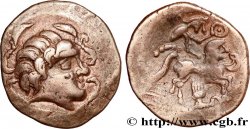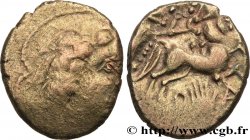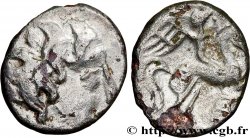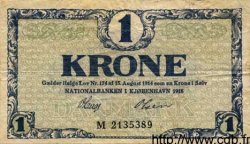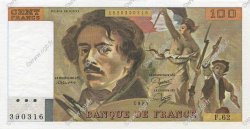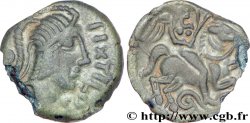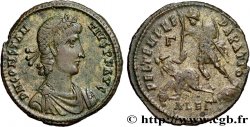bga_373281 - GALLIA - PICTONES (Regione di Poitiers) Statère d’or bas à la joue tatouée, revers à gauche
non disponibile.
Articolo venduto sul nostro negozio (2023)
Prezzo : 675.00 €
Articolo venduto sul nostro negozio (2023)
Prezzo : 675.00 €
Tipo : Statère d’or bas à la joue tatouée, revers à gauche
Data: Ier siècle avant J.-C.
Nome della officina / città: Poitiers (86)
Metallo : elettro
Diametro : 20,5 mm
Asse di coniazione : 3 h.
Peso : 6,92 g.
Grado di rarità : R3
Commenti sullo stato di conservazione:
Monnaie bien identifiable, avec des reliefs très émoussés ; de frappe mole et/ou usés
N° nelle opere di riferimento :
Diritto
Titolatura diritto : ANÉPIGRAPHE.
Descrittivo diritto : Tête (d’Ogmius) à droite, la joue ornée, le nez droit, la chevelure en grosses mèches, d’où partent des cordons perlés ; un symbole en forme de joug devant la bouche.
Rovescio
Titolatura rovescio : ANÉPIGRAPHE.
Descrittivo rovescio : Aurige tenant une couronne dirigeant à gauche un cheval androcéphale casqué ; dessous, une main sur un joug.
Commento
Ce statère d’électrum est atypique par l’ornement (tatouage) de la joue au droit (à peine visible sur cet exemplaire), mais surtout par l’orientation du cheval au revers !
Excessivement rare, ce statère est du même type que la monnaie DT. S 3656A du supplément du Nouvel Atlas Tome 4.
Sous le cheval, la main est bien visible sur cet exemplaire, traitée comme un peigne.
This electrum stater is atypical because of the ornament (tattoo) on the cheek on the obverse (barely visible on this example), but especially because of the orientation of the horse on the reverse! Extremely rare, this stater is of the same type as the coin DT. S 3656A from the supplement to the New Atlas Volume 4. Under the horse, the hand is clearly visible on this example, treated like a comb
Excessivement rare, ce statère est du même type que la monnaie DT. S 3656A du supplément du Nouvel Atlas Tome 4.
Sous le cheval, la main est bien visible sur cet exemplaire, traitée comme un peigne.
This electrum stater is atypical because of the ornament (tattoo) on the cheek on the obverse (barely visible on this example), but especially because of the orientation of the horse on the reverse! Extremely rare, this stater is of the same type as the coin DT. S 3656A from the supplement to the New Atlas Volume 4. Under the horse, the hand is clearly visible on this example, treated like a comb








 Segnalare un errore
Segnalare un errore Stampate la pagina
Stampate la pagina Condividi mia selezione
Condividi mia selezione Fai una domanda
Fai una domanda Consegnare / vendere
Consegnare / vendere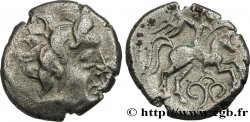
 Descrittivo
Descrittivo